The Persian Empire, with its political and cultural center in Persia, prospered from the Bouyid dynasty in 932 to the Qajars in the 19th century. The Persian school of calligraphy, rooted in the Islamic tradition, developed in Persia from the 10th century onwards, reaching its apogee between the 13th and 17th centuries.
It is renowned for its nasta’liq script, one of the most refined and emblematic styles. Persian calligraphy is distinguished by its wealth of ornamentation and decoration, incorporating floral motifs, arabesques and elaborate illumination.
Persian calligraphers are renowned for their precision and meticulous execution, creating aesthetically balanced compositions. They were influenced by eminent calligraphers such as Mir Ali Tabrizi (1330-1446) and Mir Imad Hassani Qazvini (1554-1615), who brought technical and aesthetic innovations to nasta’liq script.
1. Calligraphic styles
1.1 Tâ’lîq (14th century)
Tâ’lîq is a specifically Persian style of calligraphy, literally meaning “suspended”. It became the national script in Persia, reaching its apogee in the 16th century. Commonly used in administration and correspondence, this style of writing is derived from ruq’a and tawqî’, attributed to the famous calligrapher Tâj al-dîn Salmani (14th century).
This calligraphic style has an airy quality, with a variety of letter thicknesses and lengths, requiring ample space and forcing the calligrapher to constantly seek balance in his creation. Originally, the tâ’lîq was used to write commentaries in the margins of the Qur’an, to distinguish them from the main text. To speed up writing, letters and words can be linked together, giving rise to the broken tâ’lîq style (nâqis).
1.2 Nasta’liq (14th century)
Nasta’liq is one of the most famous and elaborate styles of Persian calligraphy It first appeared in Persia in the 14th century, and is widely used for Persian poems, including many on the wisdom of Sufi masters, literary texts and official correspondence. Legend has it that Mir Ali Tabrizî (c. 1360-1420) was inspired to use it during a dream in which Alî (c. 600-661), the Prophet’s son-in-law, asked him to take inspiration from the goose’s gait to create a new calligraphic style. Nasta’liq is characterized by curved, flowing, elegant lines and variations in letter size and thickness, capturing the beauty and emotion of poetic language.
Renowned master calligraphers such as Mir Ali Tabrizî (circa 1360-1420), Mir Imad Hassani Qazvini (1554-1615) and Mirza Gholamreza Isfahanî (1830-1884) contributed greatly to its development and popularity in Persia.
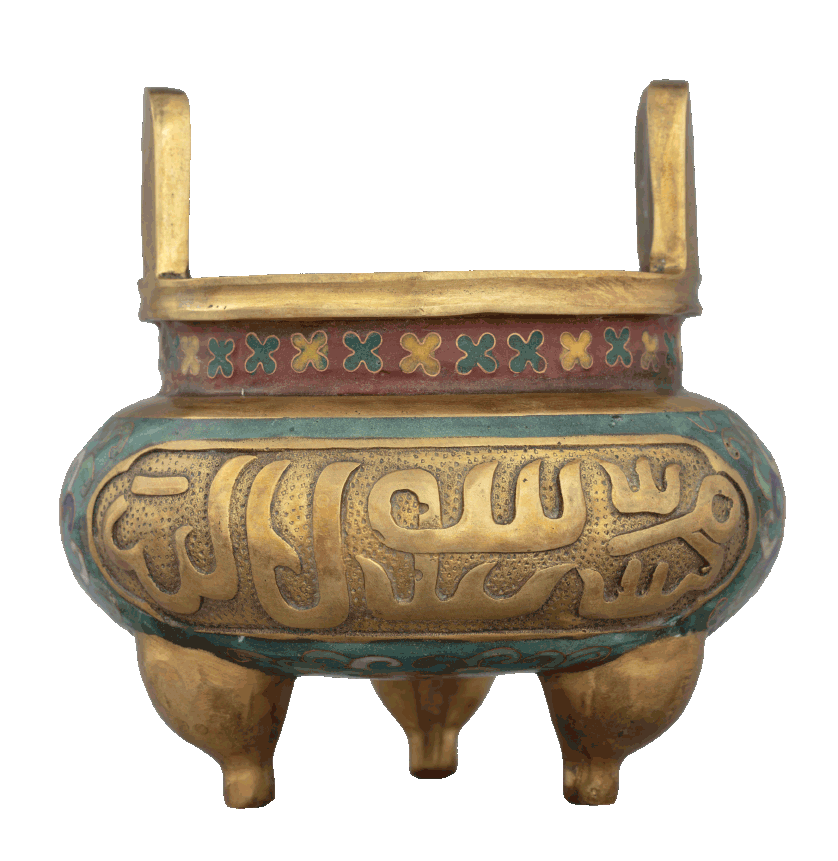
Censer
(incense burner)
Bronze, 14 x 14 cm
ADLANIA Foundation, Objects, OBJ-478
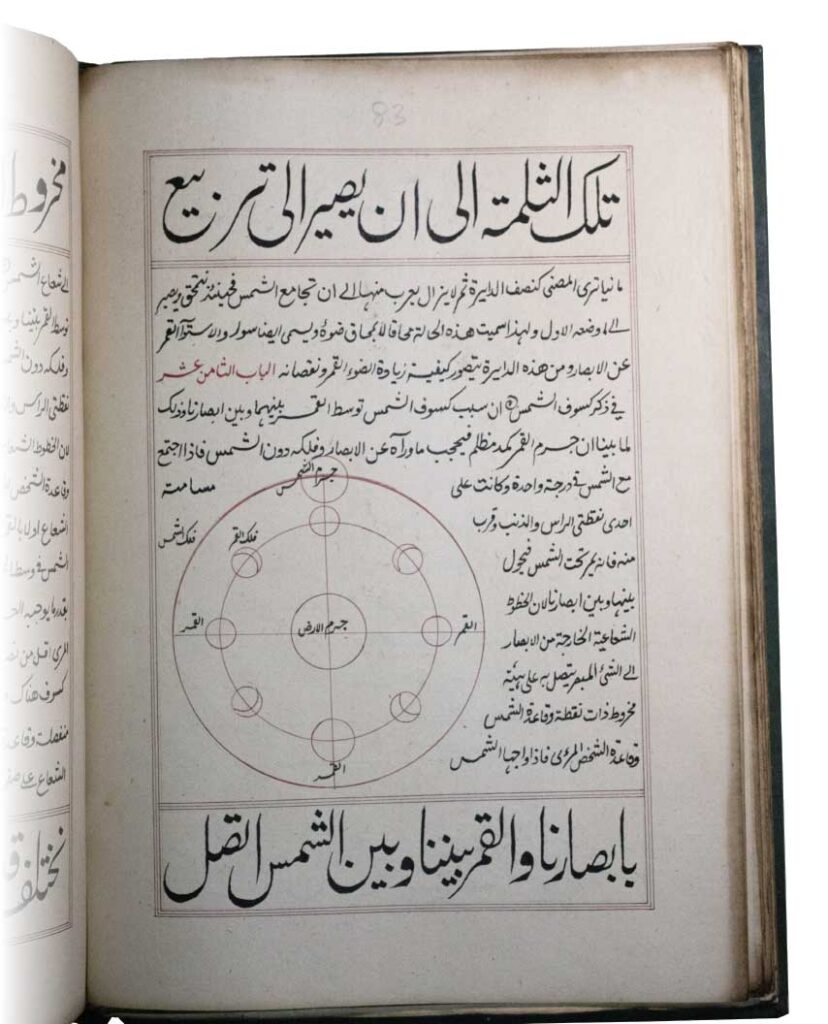
Astrological manuscript on the state of the celestial bodies, their movements and the state of the planets, by Kharâqī
13th century
Style: Nasta’lîq
Paper, 37 x 25 cm
ADLANIA Foundation, Manuscripts, MAN-629
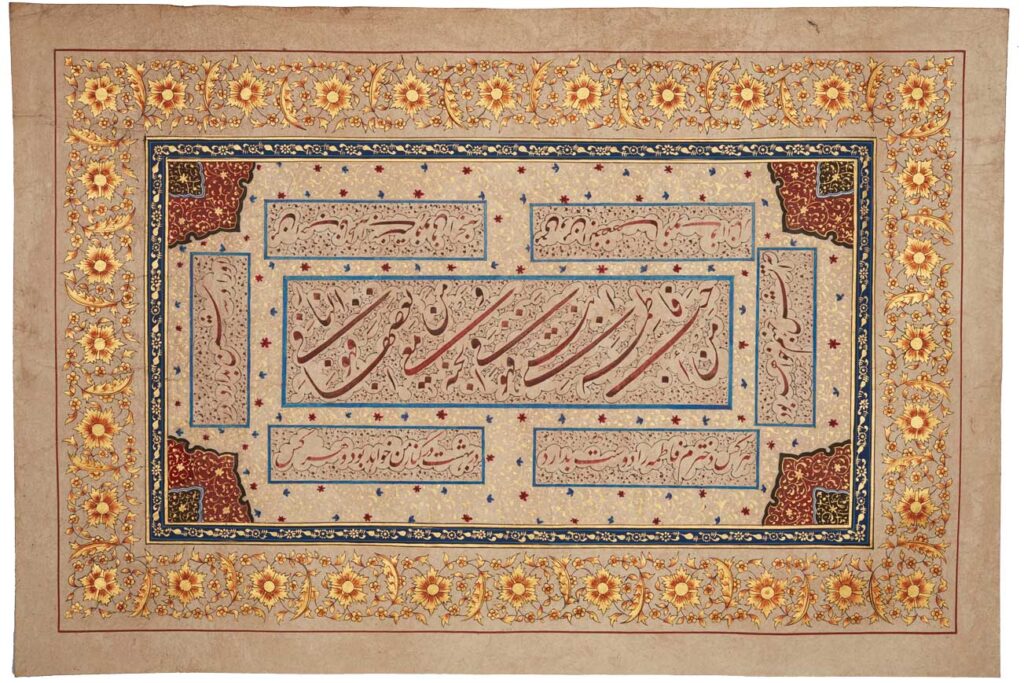
Persian calligraphy
Style: Nasta’lîq
Paper, 39.5 x 58.5 cm
ADLANIA Foundation, Manuscripts, MAN-559
2. Founding masters
2.1 Mir Ali Tabrizî (circa 1360-1420)
A calligrapher of great modesty, he enriched Arabic and Persian writing with his talent. His exceptional pen surpassed the tâ’lîq style during his lifetime. During a pilgrimage to Mecca, he asked one of his companions to offer the local authorities a biography of the Prophet, calligraphed in his own hand. The head of the mosque was about to decline the offer, when the Prophet’s face appeared to him in a dream. Since then, legend has it that Mir Ali Tabrizî was a protégé of the Prophet himself, and that the stroke of his pen brought to life that which did not yet exist.
2.2 Mir Imâd al-Hassanî (1554-1616)
A native of Qazvin (Iran), Mir Imâd al-Hassanî began his artistic journey from the time of his first studies in his hometown. His creative journey began in a painter’s studio, where he learned the technique of color, and developed a passion for the science governing the tracing of lines. Intrigued by accounts of the famous calligrapher Molla Mohammed Hosseïn (d. 1577), a resident of Tabriz, Mir Imâd decided to meet him and become his pupil.
Pursuing his quest for perfection, Mir Imâd then immersed himself in the contemplation of signs, to the point of forgetting the notion of time. His journey then took him to Turkey and other regions, where he sought to confront reality with his imagination. Finally, he decided to settle permanently in Isfahan, attracted by the city’s artistic and cultural wealth.
2.3 Mirza Gholamreza Isfahânî (1830-1886)
Mirza Gholamreza Isfahânî (1830-1886) distinguished himself as a master of Persian calligraphy during the Qajar period, particularly in the nasta’liq and shekaste nasta’liq styles. A mystic, passionate writer and man of faith, he began his education at the age of five, memorizing the Qur’an in just two years.
By the age of thirteen he was creating notable works, including a diary recounting a spiritual experience in a dream. Deeply influenced by his devotion to Imâm Ali, he reached his creative peak in the last two decades of his life. His unique style was fully expressed in his works, demonstrating his exceptional mastery of the flowing form of nasta’liq writing. One of his last achievements was the engraving of the seal of the mausoleum of Imâm Rezâ (766-818), symbolically marking the end of the calligraphic career of this undisputed master of the art of writing in Iran.
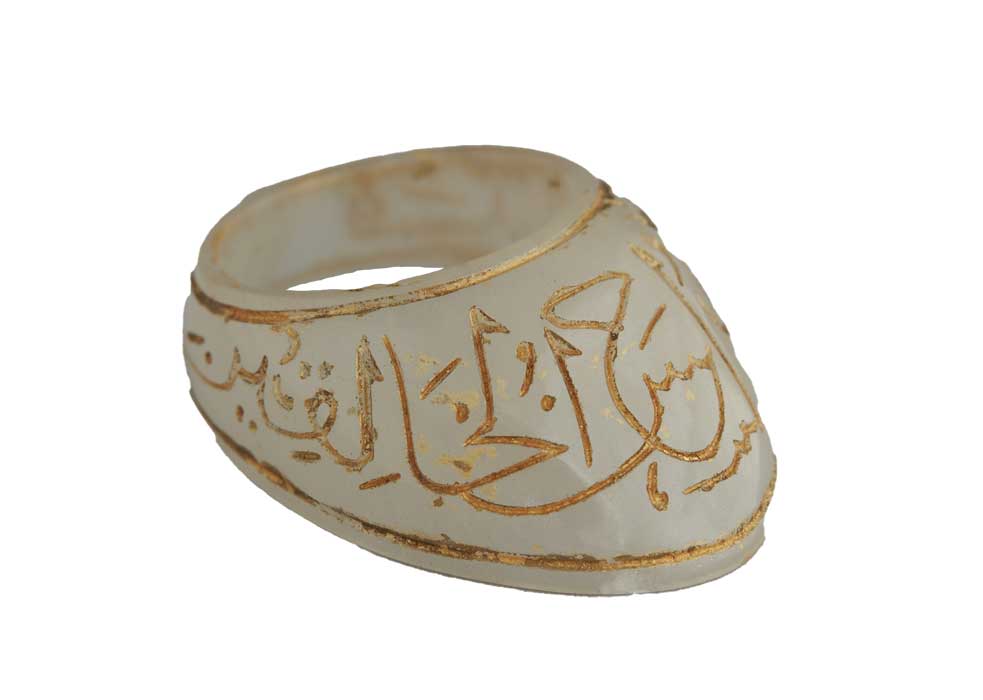
Ring
(Glory to Allah the Best of Creators)
Style: Thuluth
ADLANIA Foundation, Objects, OBJ-3120

Calligraphy of Qur’anic verses
1891
Copyist: Abd al-Qadîr
Styles: Naskhî, Thuluth and Nasta’lîq
Paper, 74 x 45,5 cm
ADLANIA Foundation, Manuscripts, MAN-558
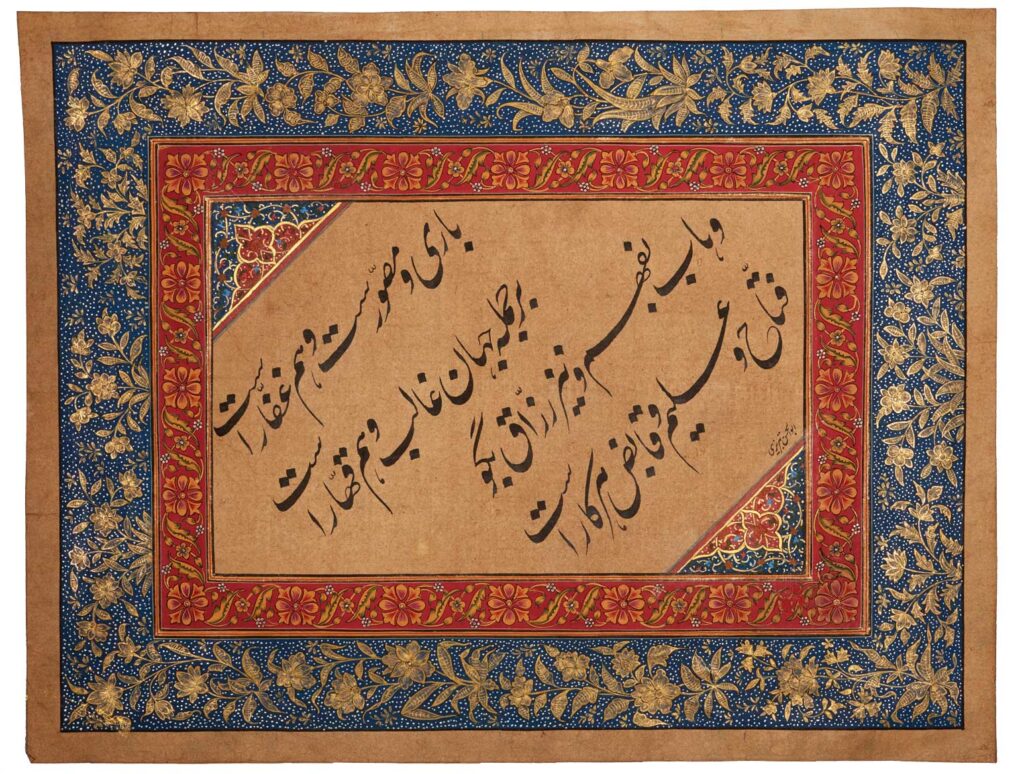
Persian calligraphy framed by floral illumination
Copyist: Abû al-Hassan Tabrîzî
Style: Nasta’lîq
Paper, 39,5 x 30,5 cm
ADLANIA Foundation, Manuscripts, MAN-424
3. Moghul school
During the Moghul period (13th-14th centuries), Islamic calligraphy was influenced by Persian, Chinese and Indian traditions, developing a unique style with the use of Moghul scripts such as Phags-pa, Soyombo and Ouighur. It was able to transmit religious texts, poems and literary works with meticulous attention to detail. The “Great Qur’an of Baydibek”, written in Phags-pa during the reign of Emperor Yuan Temür (1265-1307), is a remarkable masterpiece of this art form. The same is true of the Bihari style developed in northern India after Tamerlane’s conquest in the 14th century (1336-1405) and also found among the Muslims of Sri Lanka.
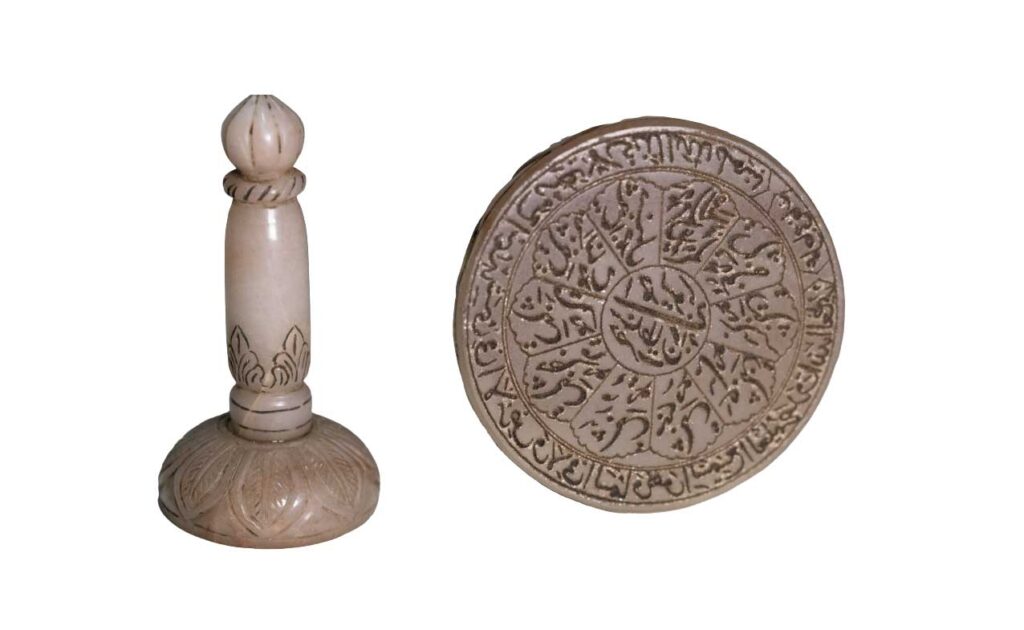
Islamic genealogical seal
made of jade
engraved with the name of Hazrat Sultan Khwaja Ahmad Yasawî
7 x 13.5 cm
ADLANIA Foundation, Objects, OBJ-3592
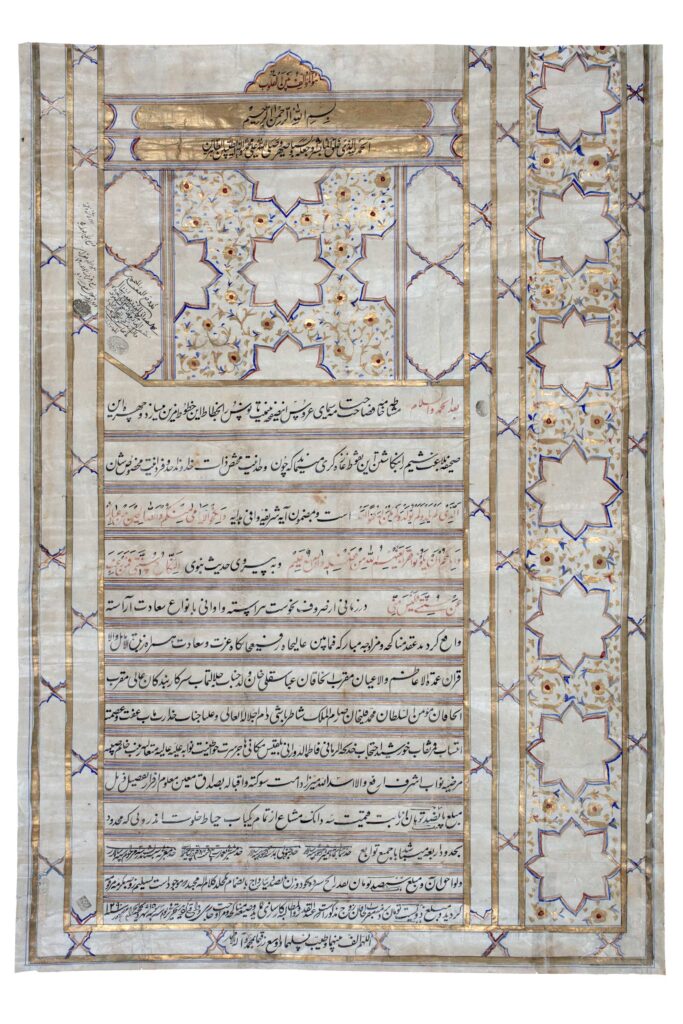
Marriage certificate in Persian
1873
Style: Nasta’lîq
Paper, 83 x 57 cm
ADLANIA Foundation, Manuscripts, MAN-521